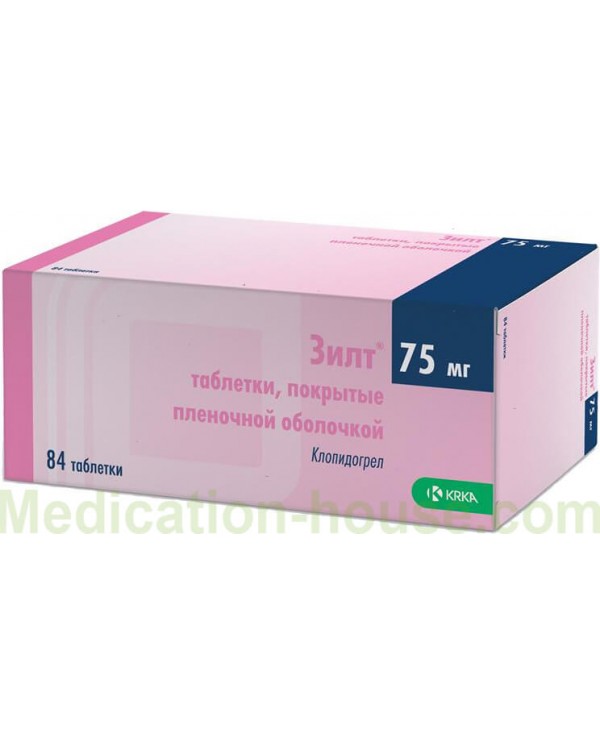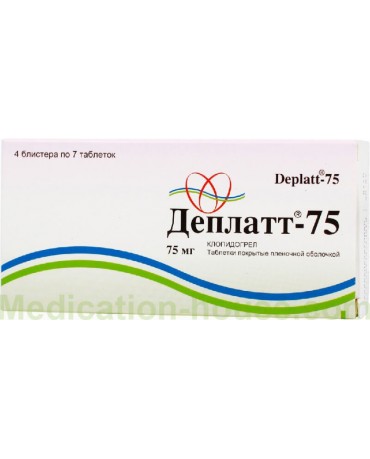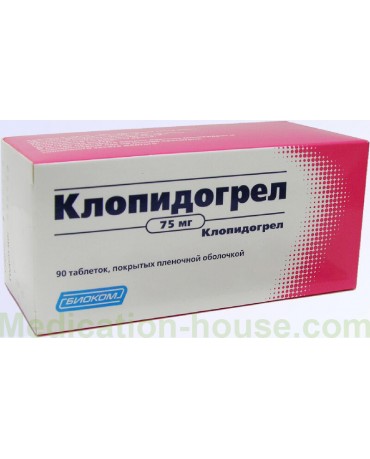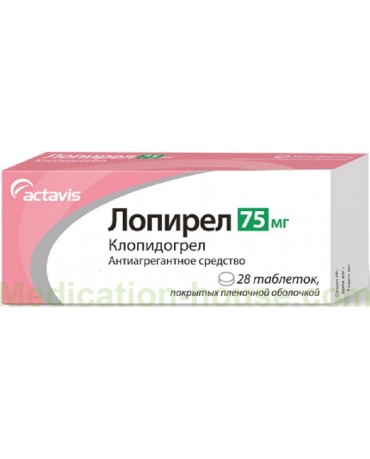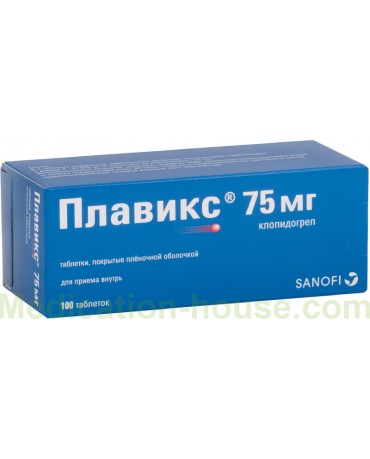Zyllt user manual
You can buy Zyllt here
Zyllt is an antiplatelet agent.
Release form and composition
Dosage form - film-coated tablets: round, slightly biconvex, pink, the core of the tablet has a white or almost white rough structure (7 pieces in blisters, in cartons of 2, 4 or 12 blisters).
The active substance is clopidogrel hydrogen sulfate, in 1 tablet - 97.875 mg, or clopidogrel - 75 mg.
Auxiliary components: microcrystalline cellulose, anhydrous lactose, pregelatinized starch, hydrogenated castor oil, macrogol 6000.
The composition of the film shell: propylene glycol, hypromellose 6cp, talc, titanium dioxide (E171), iron dye red oxide (E172).
Pharmacodynamics
Clopidogrel is a prodrug, as a result of its biotransformation metabolites are formed, one of which exhibits antiaggregatory activity. The active metabolite selectively inhibits the binding of ADP (adenosine diphosphate) to platelet P2Y12 receptors and inhibits the subsequent activation of the glycoprotein GPIIb / IIIa complex, which ultimately leads to the suppression of platelet aggregation.
Inhibition of platelet aggregation is an irreversible process that lasts for 7-10 days (cell life cycle), so the rate of restoration of normal platelet function depends on the rate of their renewal. Clopidogrel inhibits not only platelet aggregation induced by ADP, but also aggregation caused by other agonists. This is due to the blockade of enhanced cell activation under the influence of ADP.
The formation of an active metabolite occurs under the action of CYP450 isoenzymes. Some CYP450 isoenzymes can be inhibited by other drugs or differ in polymorphism, therefore, not all patients have adequate suppression of platelet aggregation.
When using the drug Zyllt at a dose of 75 mg per day, a significant suppression of platelet aggregation occurs already from the first day of treatment. Over the next 3–7 days, this effect grows, after which, upon reaching an equilibrium state, it reaches a constant level. The inhibition of platelet aggregation in the equilibrium state averaged 40-60% (when the drug was used at a dose of 75 mg per day). After discontinuation of clopidogrel, bleeding time and the degree of platelet aggregation returned to baseline levels within about 5 days.
Zyllt helps to prevent the development of a heart attack or stroke in patients with atherosclerosis of blood vessels of any location, especially with damage to the coronary, peripheral or cerebral arteries.
Pharmacokinetics
Clopidogrel is rapidly absorbed after oral administration. The maximum concentration of unchanged clopidogrel is on average 2.2-2.5 ng / ml (after oral administration of 75 mg of the drug). The time to reach maximum concentration is about 45 minutes. The degree of absorption of clopidogrel, according to data on the excretion of metabolites of the drug by the kidneys, is 50%.
Clopidogrel binds 98% to plasma proteins, its inactive metabolite - 94%. Plasma protein binding is reversible and unsaturated over a wide concentration range.
The active metabolism of clopidogrel occurs in the liver in two ways: the first is hydrolysis with the formation of a carboxylic acid derivative (an inactive metabolite, which accounts for 85% of all circulating metabolites), the second is catalysis reactions by various cytochrome P450 isoenzymes. As a result of the second metabolic pathway, 2-oxo-clopidogrel is formed from clopidogrel, which is then metabolized to the thiol derivative of clopidogrel (active metabolite). This metabolite interacts with platelet receptors, irreversibly blocking their aggregation. The maximum plasma concentration of the active metabolite after taking 300 mg of the drug (loading dose) is twice the maximum concentration after applying a daily maintenance dose of 75 mg for 4 days. It takes about 30-60 minutes to reach maximum concentration.
About 50% of the drug is excreted by the kidneys and about 46% through the intestines. The half-life of clopidogrel after a single dose of 75 mg is 6 hours. The half-life of the inactive metabolite circulating in plasma is about 8 hours.
Indications for use
The use of Zyllt is indicated for the prevention of atherothrombotic complications in adult patients with cardiovascular pathologies:
Myocardial infarction (period from several to 35 days), ischemic stroke (period from 7 days to 6 months), or diagnosed occlusive peripheral arterial disease;
Acute coronary syndrome without ST-segment elevation (myocardial infarction without Q wave formation or unstable angina pectoris), including patients with stenting during percutaneous coronary intervention, in combination with acetylsalicylic acid;
Acute coronary syndrome with ST segment elevation (acute myocardial infarction) in the case of drug treatment and, if possible, thrombolytic therapy in combination with acetylsalicylic acid.
In addition, the drug is prescribed for the prevention of thromboembolic and atherothrombotic complications (including stroke) in adult patients with atrial fibrillation (atrial fibrillation) who cannot take indirect anticoagulants, and who have a risk factor for the development of vascular complications with an insignificant likelihood of bleeding, including in combination with acetylsalicylic acid.
Contraindications
Severe liver dysfunction;
Glucose-galactose malabsorption syndrome, lactose intolerance, lactase deficiency;
Intracranial hemorrhage, bleeding from peptic ulcers and other types of acute bleeding;
The period of pregnancy and breastfeeding;
Age under 18;
Hypersensitivity to drug components.
The drug is used with caution in patients: with impaired renal function, moderate liver dysfunction with a predisposition to bleeding; with trauma, surgery and conditions that increase the risk of bleeding; with gastrointestinal, intraocular and other diseases predisposed to the development of bleeding; while taking COX-2 inhibitors and other non-steroidal anti-inflammatory drugs (NSAIDs), warfarin, heparin or glycoprotein IIb / IIIa inhibitors; with low activity of the isoenzyme CYP2C19 (due to an increased risk of cardiovascular complications); with hypersensitivity to prasugrel, ticlopidine and other thienopyridines.
Instructions for the use of Zyllt: method and dosage
The tablets are taken orally, regardless of the meal.
Recommended dosage for patients with normal CYP2C19 isoenzyme activity, including elderly patients:
Myocardial infarction, ischemic stroke, or diagnosed occlusive peripheral arterial disease: 75 mg once a day;
Acute coronary syndrome without ST segment elevation (unstable angina and myocardial infarction without Q wave): loading dose - 300 mg once, then 75 mg once a day in combination with acetylsalicylic acid at a dose of 75-325 mg per day. When prescribing, it should be borne in mind that doses of acetylsalicylic acid above 100 mg are associated with a high risk of bleeding. The therapeutic effect occurs on the 3rd month of treatment, for optimal results, it is advisable to continue the use of clopidogrel up to 12 months;
Acute myocardial infarction (acute coronary syndrome with ST segment elevation): a single loading dose, then 75 mg once a day in combination with acetylsalicylic acid and thrombolytics (or without them). It is not recommended to use loading doses when treating patients over 75 years of age. Treatment should be started when the first symptoms of the disease appear and continued for at least 4 weeks;
Atrial fibrillation (atrial fibrillation): 75 mg 1 time per day in combination with acetylsalicylic acid at a dose of 75-100 mg per day.
It is recommended to take the tablets at the same time, if you are less than 12 hours late, you should take the missed dose and the next one at the usual time, if the interval between doses is more than 12 hours, the next dose is taken without doubling.
In patients with a genetically determined reduced activity of the isoenzyme CYP2C19, when taking Zyllt in recommended doses, the formation of the active metabolite of clopidogrel is less and its antiplatelet effect is less pronounced. The optimal dosage for patients in this category has not been established; usually, the drug is prescribed in higher doses with a single dose of a loading dose of 600 mg and then 150 mg once a day.
Elderly patients do not need dose adjustment.
Side effects of Zyllt
From the side of the cardiovascular system: often - hematoma; very rarely - arterial hypotension, vasculitis;
From the hematopoietic system: infrequently - leukopenia, thrombocytopenia, eosinophilia; rarely - neutropenia, including severe forms; very rarely - aplastic anemia, thrombotic thrombocytopenic purpura (TTP), pancytopenia, severe thrombocytopenia, agranulocytosis, anemia, granulocytopenia;
From the digestive system: often - abdominal pain, gastrointestinal bleeding, diarrhea, dyspepsia; infrequently - nausea, vomiting, constipation, gastritis, flatulence, stomach and / or duodenal ulcer; rarely - retroperitoneal hemorrhage; very rarely - pancreatitis, retroperitoneal and gastrointestinal bleeding (including fatal), colitis (including lymphocytic), acute liver failure, hepatitis, functional disorders of the liver, stomatitis;
From the nervous system: infrequently - headache, intracranial hemorrhage (including fatal), dizziness, paresthesia; very rarely - confusion, hallucinations;
From the musculoskeletal system: very rarely - hemarthrosis, muscle hemorrhage, arthritis, myalgia, arthralgia;
From the respiratory system: often - nosebleeds; very rarely - bronchospasm, bleeding from the respiratory tract (pulmonary bleeding, hemoptysis), interstitial pneumonitis;
From the genitourinary system: infrequently - hematuria; very rarely - glomerulonephritis, increased serum creatinine levels;
From the side of the skin: often - subcutaneous hematomas; infrequently - itchy skin, rash, skin hemorrhages (purpura); very rarely - bullous dermatitis (Stevens-Johnson syndrome, toxic epidermal necrolysis, erythema multiforme), urticaria, erythematous rash, lichen planus, eczema;
From the senses: infrequently - retinal or conjunctival hemorrhages; rarely - vertigo; very rarely - gustatory pathologies;
Laboratory indicators: often - a decrease in the number of platelets and neutrophils, prolongation of the bleeding period;
Allergic reactions: very rarely - eczema, angioedema, anaphylactoid reactions, serum sickness; frequency unknown - drug rash with systemic symptoms of DRESS syndrome and eosinophilia, cross-reactive hypersensitivity to thienopyridines, drug-induced hypersensitivity syndrome;
Others: often - vascular bleeding at the puncture site; very rarely - heavy bleeding from the wound, fever.
Overdose
In case of an overdose of Zyllt, it is possible to lengthen the bleeding time and develop hemorrhagic complications.
In case of bleeding, appropriate adequate therapy is prescribed. For quick correction of prolonged bleeding time, platelet transfusion is performed. There is no specific antidote for clopidogrel.
Special instructions
The use of the drug is associated with the risk of bleeding and unwanted hematological events, therefore, treatment should be accompanied by systematic monitoring for signs of bleeding, especially at the beginning of clopidogrel administration, as well as after surgery or invasive cardiological procedures. In the case of clinical signs of possible bleeding, the patient should undergo a blood test to determine the number and indicators of platelet function, activated partial thromboplastin time (APTT) and a number of other necessary studies.
It is not recommended to prescribe the drug to patients with acute ischemic stroke less than 7 days old.
Zyllt lengthens the bleeding time, this must be taken into account when used simultaneously with acetylsalicylic acid, NSAIDs, glycoprotein IIb / IIIa inhibitors, heparin and warfarin.
Patients are recommended to be examined for hypersensitivity to ticlopidine, prasugrel and other thienopyridines, since cross-reactive hypersensitivity between drugs in this group is possible. If a patient has a history of hypersensitivity to other thienopyridines, he should be carefully observed during therapy in order to identify symptoms of hypersensitivity to clopidogrel.
When preparing a patient for a planned surgical operation, the use of Zyllt should be canceled 5-7 days before.
The patient should be warned about the possibility of more prolonged bleeding during the treatment period and the need to notify the attending physician about each case of bleeding. When visiting other doctors, you should always inform about taking clopidogrel, this information is important both when prescribing new medicines and when visiting a dentist.
Against the background of the use of Zyllt, thrombotic thrombocytopenic purpura may develop, which is characterized by thrombocytopenia and microangiopathic hemolytic anemia associated with impaired renal function, neurological disorders and fever. This condition requires urgent medical attention, including plasmapheresis.
Treatment should be carried out with monitoring of liver function, since with severe functional disorders, hemorrhagic diathesis may develop.
The content of hydrogenated castor oil in the preparation can cause diarrhea and indigestion.
Zyllt does not affect the patient's ability to drive vehicles and mechanisms and perform other potentially hazardous activities that require a high speed of psychomotor reactions and concentration.
Application during pregnancy and lactation
According to the instructions, Zyllt is not recommended for use during pregnancy, since there are no clinical data on the use of clopidogrel in pregnant women. Studies carried out on animals have not revealed any direct or indirect negative effect of the drug on the course of pregnancy, fetal development, childbirth or postnatal development of the child.
In experimental studies on animals, it was found that clopidogrel and its metabolites pass into breast milk, therefore, if it is necessary to use Zyllt in lactating women, breastfeeding should be discontinued.
Childhood use
Zyllt is contraindicated in children and adolescents under 18 years of age, since today the safety and effectiveness of its use in children and adolescents have not been established.
With impaired renal function
With repeated use of Zyllt at a dose of 75 mg per day in patients with severe renal impairment (creatinine clearance - 5-15 ml / min), the degree of suppression of platelet aggregation was 25% lower than the degree of inhibition of platelet aggregation compared with healthy volunteers. However, the lengthening of bleeding time was similar to that in healthy volunteers who received Zyllt at a dose of 75 mg per day. Zyllt is well tolerated in all patients.
For violations of liver function
The use of the drug at a dose of 75 mg per day for 10 days did not cause significant changes in the degree of platelet aggregation and the rate of lengthening the bleeding time in patients with severe liver dysfunction compared with the same indicators in healthy volunteers.
Use in the elderly
In elderly patients aged 75 years and older, Zyllt is used in the same doses as in younger patients. No dose adjustment is required.
Drug interactions
Due to the high risk of bleeding, it is not recommended to prescribe Zyllt simultaneously with warfarin, and when combined with heparin and other thrombolytic agents, special care should be taken.
NSAIDs increase the risk of ulcers and bleeding ulcers in the gastrointestinal tract.
No clinically significant interaction was found with simultaneous use with atenolol, angiotensin-converting enzyme (ACE) inhibitors, drugs that lower blood cholesterol, digoxin, nifedipine, phenobarbital, estrogens, cimetidine, theophylline.
Clopidogrel may increase the effect of acetylsalicylic acid on collagen-induced platelet aggregation. Pharmacodynamic interaction of the drug with acetylsalicylic acid increases the likelihood of bleeding, therefore, the use of this combination is possible only for 1 year.
The absorption of clopidogrel is not affected by antacids.
The combination with tolbutamide, phenytoin increases the level of their concentration in blood plasma.
Terms and conditions of storage
Store at temperatures up to 25 ° C. Keep out of the reach of children.
The shelf life is 3 years.
Reviews of Zyllt
Patients speak well of Zyllt, noting not only its effectiveness, but also an acceptable price (compared to some more expensive analogues). According to reviews, Zyllt is effective after suffering heart attacks and stenting procedures. Patients note an improvement in general well-being, cessation of angina attacks, as well as the absence of arterial and venous thrombosis.
Sometimes patients complain of side effects (urticaria, severe shortness of breath), but if you continue treatment, then unwanted side effects go away after a while.
Terms of sell
You don't need a prescription to buy Zyllt.

